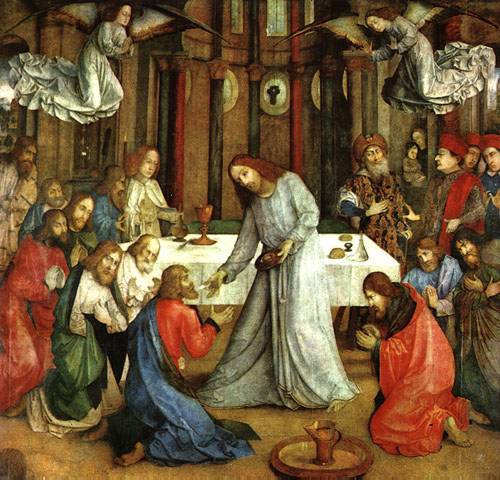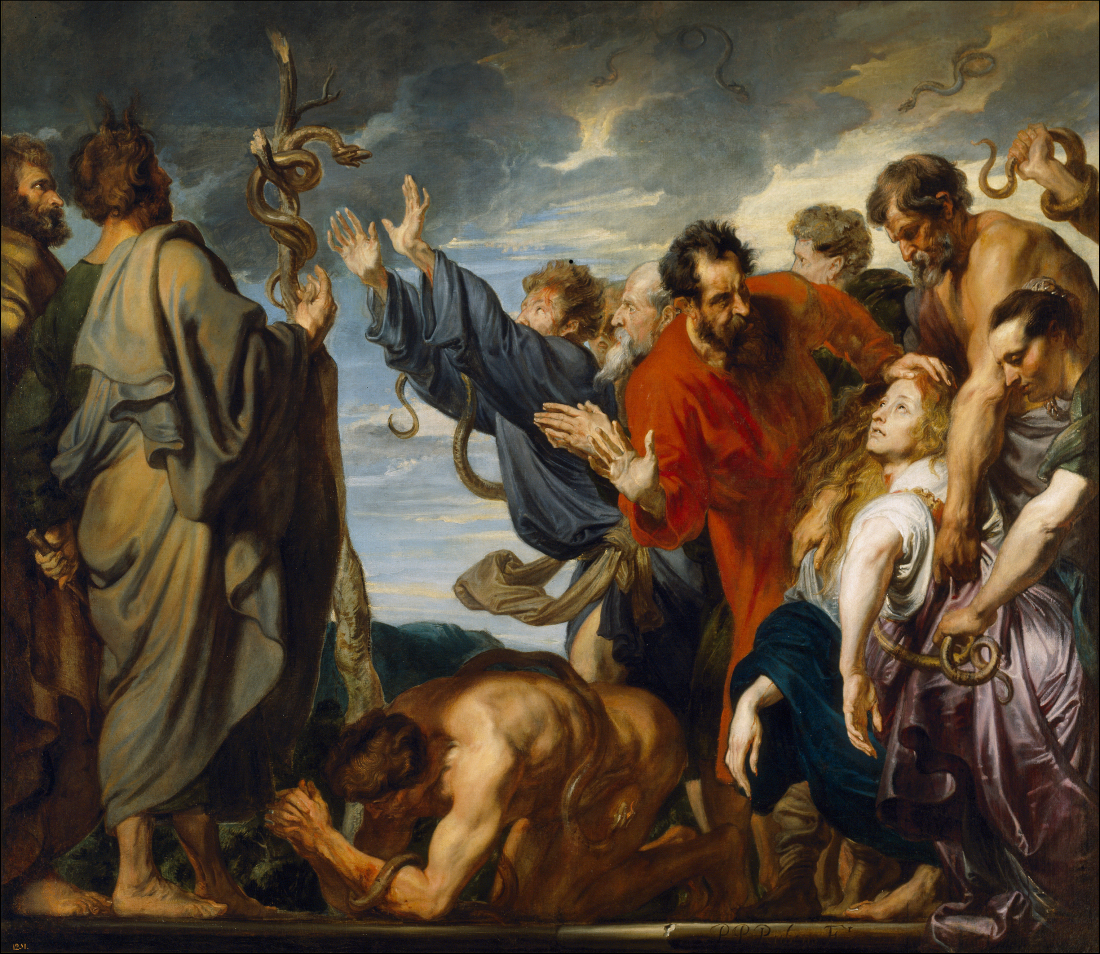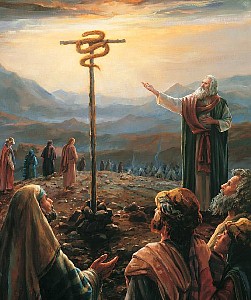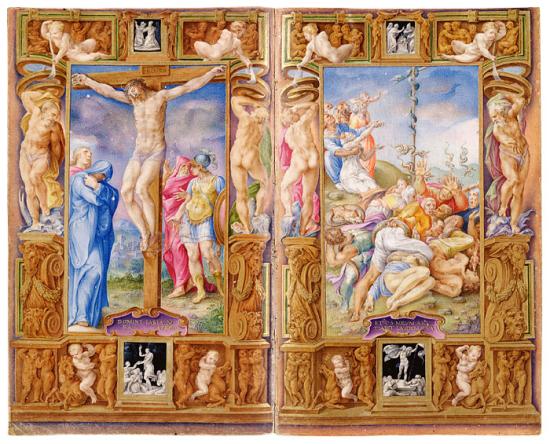The 14th of September marks the Feast of the
Exaltation of the Holy Cross.
A Bit of History
The Feast of the Exaltation of the Holy Cross dates back to 335 A.D. at the dedication
of the Church of the Holy Sepulchre: the location believed to be where Jesus’
body was interred. The 14th September marked the second day of a
festival commemorating the relic of the true cross, brought out of the church
for the veneration of the faithful.
.jpg/479px-Helena_of_Constantinople_(Cima_da_Conegliano).jpg) |
| Saint Helena of Constantinople, National Gallery of Art (US). |
It is traditionally believed that the relic of the true
cross, upon which Jesus was crucified, was discovered nine years earlier in 326
(according to some accounts, even earlier) by St. Helena—the mother of the
Roman Emperor Constantine—whilst on pilgrimage to the Holy Land.
Theodoret’s (d. 457 A.D.) account goes as follows:
When the empress beheld the place
where the Saviour suffered, she immediately ordered the idolatrous temple [of
Venus], which had been there erected [probably under Hadrian], to be destroyed,
and the very earth on which it stood to be removed. When the tomb, which had
been so long concealed, was discovered, three crosses were seen buried near the
Lord's sepulchre. All held it as certain that one of these crosses was that of
our Lord Jesus Christ, and that the other two were those of the thieves who
were crucified with Him. Yet they could not discern to which of the three the
Body of the Lord had been brought nigh, and which had received the outpouring
of His precious Blood. But the wise and holy Macarius, the president of the
city, resolved this question in the following manner. He caused a lady of rank,
who had been long suffering from disease, to be touched by each of the crosses,
with earnest prayer, and thus discerned the virtue residing in that of the
Saviour. For the instant this cross was brought near the lady, it expelled the
sore disease, and made her whole.[1]
Purpose of the Feast
 Outside of this specific historical context, the feast
day is a dedicated day on which the Church celebrates and recognises the
mystery of the Cross as the instrument of universal salvation, and as the
perennial symbol of God’s love for us. Interestingly, the word “salvation” in
Greek in its broadest sense refers to health, wellbeing and welfare in the
holistic sense, the body included. This ties in with Theodoret’s account above
which involves the healing of an ill woman by means of the cross.
Outside of this specific historical context, the feast
day is a dedicated day on which the Church celebrates and recognises the
mystery of the Cross as the instrument of universal salvation, and as the
perennial symbol of God’s love for us. Interestingly, the word “salvation” in
Greek in its broadest sense refers to health, wellbeing and welfare in the
holistic sense, the body included. This ties in with Theodoret’s account above
which involves the healing of an ill woman by means of the cross.
On the Cross, God’s love is made
manifest—demonstrated in the Crucified-One, wounded and bloody, nailed with
arms open in a gesture of the Word, that speaks louder than words. A gesture
which comprises the message of the Gospel, the Good News, that “God so
loved the world that he gave his only begotten Son, that whoever believes in
him shall not perish but would have eternal life.” (Jn 3:16).
Moses and the Bronze Serpent
A key motif of the readings designated for the Mass of the Feast is the bronze serpent
which Moses lifted up in the wilderness. To cut a short story shorter: the
Israelites, who despite been delivered miraculously from the slavery of Egypt,
were complaining once again about God and the leadership of Moses. Serpents are
sent as a result, and many of the people are bitten and die. In turn the people
plead with Moses to intercede with God. Moses pleads, God answers and tells him
to fashion a serpent from bronze, and to place it on a stand and lift it up.
Moses is told that anyone who is bitten who looks at this serpent, will be
healed. Moses does as he is told, and the people are healed by gazing at the
bronze serpent.
Jesus—The Bronze Serpent
In the Gospel of John, Jesus draws a direct parallel with
his pending crucifixion and the bronze serpent of Moses:
And as Moses lifted up the serpent
in the desert, so must the Son of man be lifted up: That whosoever believeth in
him, may not perish; but may have life everlasting. (Jn 3:15).
Here Jesus explains that the bronze serpent of Moses was
merely a foreshadowing of His being lifted up on the standard of the Cross. As
gazing upon the former bronze serpent brought about the physical and temporal
healing of the body, so the gazing in faith upon Jesus Crucified, as the only
Son of the Father sent to die for our sins, brings about the spiritual and
eternal healing of the soul by means of redemption.
The Biter Got Bit
The Old Testament recounts that the cause of the people’s
ailment was the bite from serpents. This reminds us of the Genesis creation
account, where a serpent (interpreted as Satan in disguise) deceives Eve and
leads her to sin by breaking God’s command and eating the forbidden fruit. Adam
joins the party, and we have what the Church calls Original Sin: the first sin,
which is the cause of our ‘natural’ state of disunion with God.
In a figurative sense, we can say that by achieving the
deception of Eve, Satan in the guise of a serpent bit Eve, ironically through
her biting into the forbidden fruit; and by Adam’s yielding to Eve’s invitation
to bite the fruit, Adam was bit in turn. The poison of concupiscence—of evil
inclination—was injected into their souls, and thus into every human being
henceforth. Fundamentally good, yes, but now inclined towards evil.
The poison: concupiscence. The ailment: Original Sin. The
remedy: the true bronze serpent—Jesus Christ, the Saviour of the world, who was
lifted up on the Cross, that whosoever looks upon Him with the eyes of their
heart, believing that He is the Son of God, Love Incarnate, will in turn be
healed interiorly.
Baptism: The First Look
Baptism is ordinarily the first look—a turning of the
eyes of the soul in faith, towards Jesus—which heals the soul of the ailment of
Original Sin. Adults do so by their own faith, young children by the faith of
their parents. Those baptised past the age of reason are healed of all personal
sin as well—those under age not having any to be healed of. Yet life happens,
we’re imperfect creatures, and so we need to return to the divine physician.
Confession: Extraction and Anti-Venom
Thus, the Sacrament of Reconciliation, of Confession comes
into play, which is one of the two key sacramental ways in which the soul gazes
upon Christ. The sacrament restores and renews the soul’s health by extracting the
poison of concupiscence in the form of personal sin.
Mortal sin is like a fatal
dose of such poison, from which the soul must be revived; and each venial sin a
non-fatal dose, smaller or larger, which needs to be extracted to restore the
soul to full health. The Sacrament of Confession sacramentally accomplishes
this.
Private and personal repenting
in perfect contrition is essential and also accomplishes this, yet it ought to
serve as a staple-compliment to the frequenting of Confession as minimally required
by the wisdom of the Church, and in the instance of mortal sin, must be followed
by a hasty Confession.
The Sacrament of Mercy, as
Pope Francis so calls it, is a load-lightening gift from God. It’s the hospital
bed every Catholic is invited to lie upon. Our embarrassment stemming from pride
ought not keep us away! It would be akin to one of the Israelites, if upon
being instructed that gazing upon the bronze serpent would heal him, refused to
do so, simply out of pride of not admitting he was bitten. Like the bronze
serpent, held up by Moses for all to see, Christ is there, hanging on the
Cross, spiritually waiting in our hearts for our repentance, and in the
confessional to absolve us. Healing itself, as a God-Man, reaches out to us,
all we need is to take hold of the opportunity while we have it.
Confession is not only the
means for extracting the poison of sins committed, but it administers the anti-venom
of God’s grace, bestowed through this Sacrament, which strengths the soul against
further “bites”.
We may not always feel it
emotionally, perhaps somewhere deeper down—but regardless, the reality takes
place: the bloodstream of the soul is cleansed by this Sacrament. Reviving the
soul with a joy and peace the world cannot give.
St. Pope John Paul II understood this well, and is why he supposedly frequented Confession every day! Not that everyone should frequent the sacrament every day, since this could fan scrupulosity in many, but nonetheless, as usual, the saints show us what’s important and inspire us to imitate in accord with our unique personality. We are asked to do so at least once a year, but weekly, fortnightly, or monthly, is an excellent practice.
St. Pope John Paul II understood this well, and is why he supposedly frequented Confession every day! Not that everyone should frequent the sacrament every day, since this could fan scrupulosity in many, but nonetheless, as usual, the saints show us what’s important and inspire us to imitate in accord with our unique personality. We are asked to do so at least once a year, but weekly, fortnightly, or monthly, is an excellent practice.
The Eucharist: The Healer in Our Midst
 |
| "Jesus giving Communion to the Apostles," Joos Van Wassenhove, 1472. |
The Holy Eucharist is the crème de la crème of the Sacraments.
The remedy of remedies. The most important sacramental means by which we look
upon Christ. The Sacrament by which we not only gaze in Adoration upon the
Crucified Christ, disguised under the appearance of bread; but by which we come
into real contact with the Healer of our Souls in the reception of Holy
Communion.
CCC 1394 states: “As bodily
nourishment restores lost strength, so the Eucharist strengthens our charity,
which tends to be weakened in daily life; and this living charity wipes away
venial sins.” Indeed, reception of the Eucharist is our manna in the wilderness
of this life. It strengthens us in our pilgrimage to heaven, and in our mission
to love God and neighbour alike. By receiving His wounded and glorified Body,
we are healed and sanctified—instantly in soul, and by pledge, in our bodies. By
receiving His innocent and pure Blood, are own blood, poisoned with sin, is
transfused with His innocence and purity.
Funnily enough, the temporal manna was part of the reason
the Israelites were complaining against God and Moses. They were sick of it. Sadly,
as Catholics, we often lose sight of the glorious reality of the Eucharist, and
the supreme gift and fount of grace which it is.
Like the Israelites, we can
grow indifferent to the Eucharist, perhaps even losing faith in the Real
Presence—that Jesus isn’t simply symbolised by the bread and wine, but that He is
truly and really present under the outward form of bread and wine. This is why
it’s important to call out to Jesus, like the people called out to Moses,
asking Jesus to give us the faith we need to believe He is with us in the Eucharist.
And if we already have such faith, to call out to Jesus that He might spread
that belief so that all would come to taste the beauty of this Sacrament which restores the soul who beholds the Healer behind the mask.
The serpents came to the Israelites
as a result of their ingratitude and indifference to God’s gift in the temporal
manna. This teaches us that when we knowingly put Jesus in the Eucharist to
one-side, without letting the Eucharist be at the center of our lives, we unnecessarily
open ourselves to various kinds spiritual serpents which will attack our faith,
hope and love.
The Loving Gaze of Adoration
 |
| 'Healing the Man Born Blind," Duccio, 1308 - 1311. |
St. Augustine commends us to adore Him who we receive.
Beyond reception of Jesus in the Eucharist, by which we consume the Divine
Healer and Physician into our souls, Eucharistic Adoration is the means by
which we lovingly gaze into Him who although is before us sacramentally, is
mysteriously within us by grace. These loving gazes which we cast upon Jesus in
the Eucharist vivify our souls in grace, and infuse in us blessings which will
endure in paradise.
Yet Jesus gazes out upon us as
well, peering through the lattice of the accidents of bread and wine (Song 2:9)—penetrating
our souls with a gaze which melts and heals the soul in love. So profound is
this invisible gaze of love, hardly able to be sustained at its climax, that in
respect to the soul and to Jesus, the words from the Song of Solomon apply:
“Turn away thine eyes from me, for they have overcome me” (6:5). Or as might
otherwise be translated: “they have overwhelmed me”, “they have captured me”.
The time we dedicate and set aside to spend in the presence
of Jesus in the Eucharist, is time spent under the standard of the true bronze
serpent, Christ Crucified—time not wasted, as the economic mind-set of the
world would see it, but time invested in healing us, and through us, the
Mystical Body of Christ. Since when we come before Jesus in the Blessed
Sacrament, we bring everyone along with us, past, present and future. When we
adore, we must therefore cultivate that sense of adoring on behalf of everyone.
For in our gazes on Jesus, we can gaze on behalf of all, in the faith that as
Jesus pours healing on us, He is pouring healing on the entire world in every
generation. Since Jesus’ love and healing cannot be confined by space or time.
The Glance of Prayer
Then comes prayer. Personal and private prayer, carried
out in the secrecy of our hearts. There is no limit to the amount of times we
can turn the eyes of soul in faith, towards the standard of the Cross.
Silently. Perhaps with a word of praise or invocation through the day. By means
of devotionals, such as the Rosary, wherein we join Mary in Her perfect and
profound gaze on Jesus.
Joining in the Perfect Gaze of Mary
Indeed, we cannot forget Mary. She alone can teach us the
art of that loving and trusting look. That uncompromising gaze which is fixed passionately
on Jesus, in profound reverence and confidence. It’s a good thing we can claim
in faith, Mary’s own perfect-loving gaze. In time, we will be swept up by it as
Joseph was, who through Mary perfected this art in his own right. Gazing upon
Jesus as an infant, and worshipping Him in his heart. In turn, John the Beloved
became an apprentice of this trade, studying under the Virgin Mary. The trade
of Adoration, passed down through the ages from loving soul, to loving soul.
The Moses-Call: Lift Up!
What else can be said but a summons to imitate Moses, who
lifted up the bronze serpent for the healing of the people. Sure, the
ministerial priest does this very act in a unique and remarkable way, at the
elevation of the Host, and in Eucharist processions and Benedictions. Yet as
baptised Christians, we are members of the royal priesthood—the priesthood
which the Church teaches is common to all. By means of this priesthood, we have
the privilege and the responsibility to lift up Jesus in our hearts, through
our worship and praise. In prayer, deed and in our very lives, by our witness
in ordinary living.
At its worst the countenance
of a Christian can be a moralistic harbinger of judgement, an illuministic
plaster void of authentic spirit, or a pietistic mask grinning as an expression
of a “love-bomb” technique that seeks to proselytise for reasons of self-glory instead
of sincere love. But at its best, the countenance of a Christian can radiate
the healing presence of Christ, through a genuinely human smile, a hearty
laugh, or a look of appreciation and recognition—especially to those “bitten”
by society and pushed into the shadows. The poor, the homeless, the elderly. Yet
the business man and the cash register deserve no less. Everyone unknowingly
suffers from the original “bite” and the poison of sin, and thus everyone
intrinsically craves for the healing which comes from meeting eye to eye with Christ.
The nearest they might get is a genuine look from someone like ourselves—and as
imperfect as we are, God’s love within us transcends it all.
The fashioning of the bronze serpent and the healing derived therefrom, arose from the intercessory prayer of Moses. Thus in addition to lifting Jesus up in our interior lives and
exterior lives, is lifting Jesus up in prayer carried out in the Spirit for the benefit of others. Prayer
which is simply filled with the intent to bring Jesus to all so that spiritual
healing might come to all the nations and their people—to every man, woman and
child. Do we not know that by a simple intent we can spiritually lift up the
Cross of Christ in any country, town or home, thereby bringing healing to such
places, to those open to such graces? We do not need to be physically present,
all we need is the faith and desire to do so. “Ask and you shall receive.” We
can raise up the standard of the Cross even into the realms of purgatory, thereby
placing before the holy souls the Crucified One, who upon gazing upon Him they’ll
be able to increase in healing, quickening their time of purgation, all by
means of such prayer.
We can visit the dying, even
if we cannot be physically present. We can visit the sick, and imprisoned.
Nothing substitutes for a physical presence, unless of course our state and
vocation in life dictates otherwise, but such ministry carried out spiritually can
accompany our concrete deeds, all by means of faith. By praying for anyone, we
attend to them in the Spirit, and join them in drinking from the healing poured
out upon those who gaze in trust upon the Lord.
Conclusion
Moses brought the bronze standard to the people, thereby
bringing them healing. Let us carry forth the Cross of Christ, in prayer, word
and deed, in our hearts and on our walls, to all people, especially those in
our parishes, schools, families, workplaces and communities. The Gospel, the Goods
News, that “God so loved the world that he gave his only begotten Son, that
whoever believes in him shall not perish but would have eternal life” is preached
the loudest by one who lifts up the cross in their own life, by embracing it
with full vigour, eyes fixed on Christ, and directed towards the peak of
Calvary to join Him in the consummation of love.
This gaze involves the
Sacraments, it involves Mary after the pattern of Joseph; prayer and adoration,
corporeal acts of mercy, and spiritual acts of mercy. All these solidify the
gaze of love which finds its fulfillment in beatitude.
On this note, the words of the
peasant who used to spend hours in front of Jesus in the Eucharist, apply—as a
call to adore, and as offering an insight into what heaven will essentially
involve. One day, the Cure de Ars asked the peasant, “What do you say to Jesus
during all this time of prayer?” The peasant simply responded, “Nothing, I look
at Him and He looks at me.”
[1]
Theodoret, Ecclesiastical History Chapter xvii. “Venus” inserted as per the
account of Eusebius on the Holy Sepulchre, and “Hadrian” as per being the most
likely historical candidate.




No comments:
Post a Comment